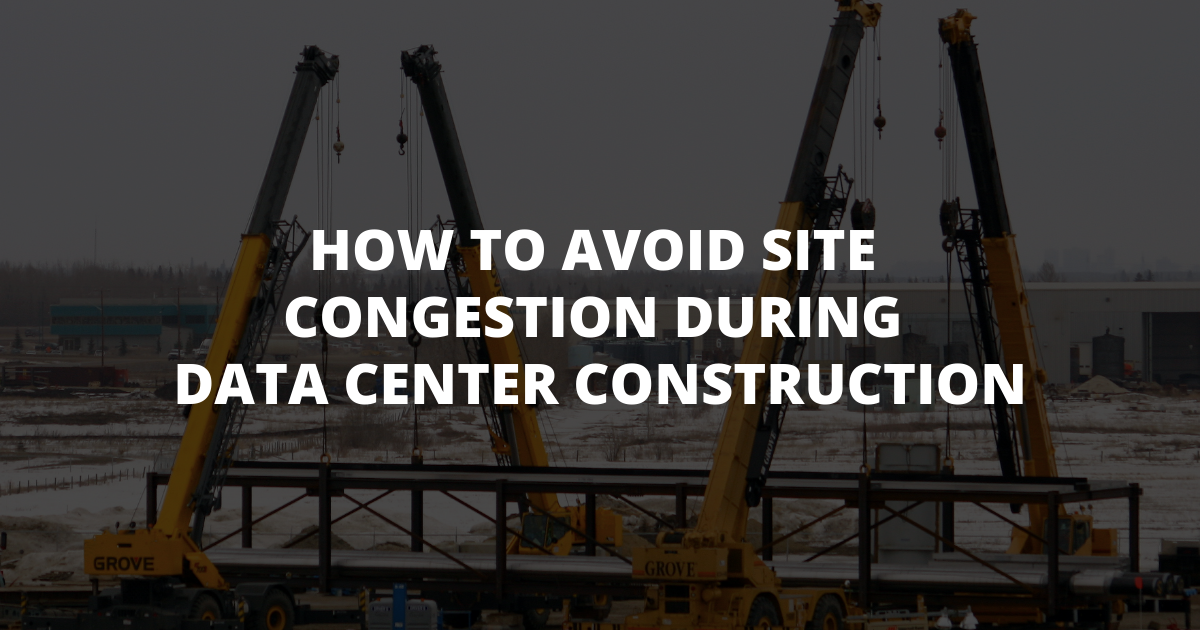How to Avoid Site Congestion During Data Center Construction

Although 2020 is winding down, there’s no slowdown in sight for the data center market. Growth projections for at least the next couple years are staggering. In a November 2020 CAPRE presentation, Sean Brady with Cushman & Wakefield reported that, “The largest cloud services providers have used all their previously taken capacity from 2018 and require more.” He further noted that, “Global colocation supply is expected to increase from 13.1 GW to 17.6 GW by 2024. For context, this would be the equivalent of three new Northern Virginias (the largest global market) in the coming four years.” This type of growth will equate to a substantial amount of new infrastructure. Speed to market remains king, and construction contractors must be poised to support with improved efficiency.
Large scale data center construction sites are quite complex. Multiple trades work simultaneously, a steady flow of equipment deliveries occur, a lot of heavy machinery is in constant motion, key construction schedules often collide, etc. The combination of these dynamics usually results in site congestion. Although data center construction projects typically include staging areas for crews and equipment, the sites get congested quickly. It’s almost unavoidable…almost.
Site congestion poses several threats to key construction milestones. It bogs down the construction process, causes unnecessary safety risks (i.e. heightened risk of COVID-19 exposure), increases on-site staff hours, and fogs communication and planning among contractors. Project success includes completed milestones in expected timeframes, so it’s imperative to deal with site congestion before it occurs.
Fortunately, there are at least a few practical ways to avoid site congestion. Below are five proven methods:
- Just-in-Time (JIT) Equipment Deliveries: Ideally, OFCI equipment is delivered directly to the contractor/installer at the time of need. This is the best-case scenario. For instance, a generator, power center, cooling unit, etc. would be delivered directly to the crane hook (bypassing the designated staging area) to be lifted and set at precisely the right time in the construction process. While this method sounds simplistic, it requires intense coordination among key stakeholders. An October 2018 blog post by NEHP, Inc. states, “The JIT method also requires that suppliers and contractors collaborate at a higher level than in regular construction methods and it requires that all project supplies are up to standard. This helps to prevent project delays…”
- Synchronizing Schedules: As the demand for data centers rapidly increases, OEMs face a production challenge of shorter lead times. Moreover, OEMs must align production schedules with construction timelines. This presents a logistical puzzle that often involves the owner, manufacturer, trucking company, 3PL, contractor, rigging company, etc. Congestion and delays are reduced when these schedules are adequately synced. This is no small feat.
- Buffering with Off-Site Storage: Nearly every construction project experiences unforeseen equipment production and transportation hiccups. This strains the original planned construction timelines, and it can be difficult to accommodate unplanned equipment deliveries on site. An off-site temporary warehouse acts as a pressure relief valve. Equipment can be delivered to the warehouse, then it can be fed to site as needed for offload and installment.
- Utilization of Specialized Equipment On-site: The typical data center construction site is large; however, workspace is usually limited, and conditions can be hectic. Therefore, it’s tricky to maneuver heavier equipment and gear around the site. Utilizing specialized equipment to navigate tight spaces and tough conditions helps improve install efficiency and reduce further congestion. One example is a self-propelled transporter (trailer), such as the PowerHoss. Its high load capacity and compact maneuverability helps shuttle mission critical equipment around site with ease and precision.
- Coordinated Logistics Management: In a May 2017 online article, Bill Brisse stated, “Unfortunately, if logistics are considered at all for a construction site, it is usually as an afterthought. The absence of a logistics plan for a construction site can lead to the creation of bottlenecks that place a stranglehold on the project”. Therefore, a good logistics plan developed on the front end will help avoid congestion. That said, the plan alone is not enough. Someone must tightly manage the overall logistics plan throughout the construction process to ensure and protect predictable outcomes.
Over the past decade, ProLift Rigging Co. has worked closely with countless data center owners, contractors, and manufacturers to avoid site congestion and accelerate critical construction timelines. The key has been the combination of some or all the methods above, which ProLift refers to as Project Buffering. This has led to deep strategic partnerships that include high levels of trust, visibility, collaboration, and value. If the data center market growth projections hold true, these types of partnerships will be critical in the quest to expand the cloud.